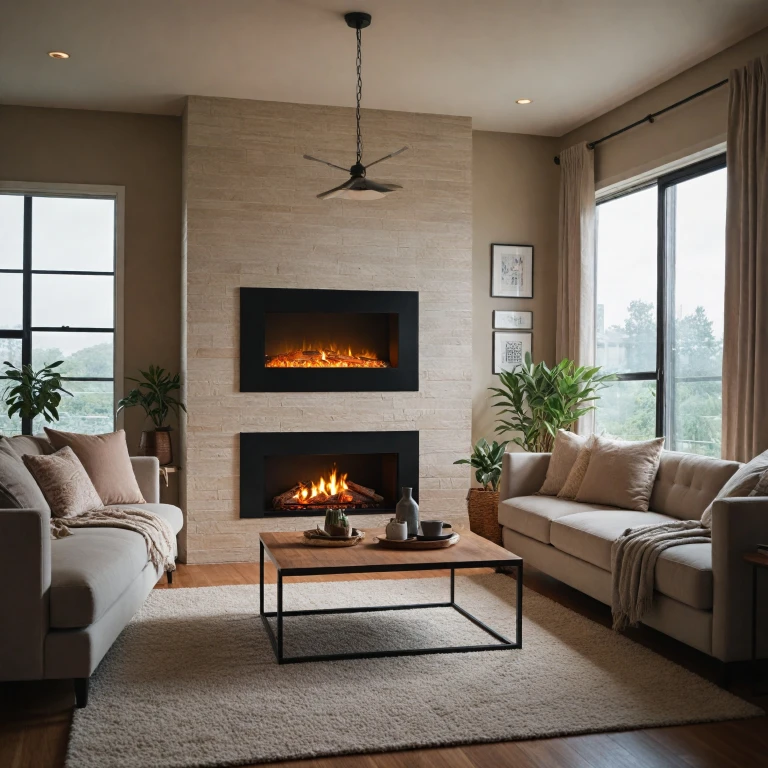How Electric Fireplaces Work
Unraveling the Basics: The Functionality of Electric Fireplaces
Electric fireplaces have gained popularity as a convenient and eco-friendly alternative to traditional heating methods. Unlike wood-burning or gas fireplaces, they primarily rely on electricity to provide heat without combustion.
Imagine transforming your living room ambiance with just the flip of a switch. That's the charm of these modern devices:
- Heat Generation: They utilize metal coils to generate heat. Once the coils heat up, a fan forces the warm air into the room, creating a cozy atmosphere.
- Flame Illusion: While there's no actual fire, electric fireplaces mimic the appearance of flames using LED lights and reflectors, adding a comforting glow without the hassle of ash or smoke.
- User Convenience: With adjustable settings for both flame and temperature, users can tailor their experience to their comfort level, all while minimizing electricity usage.
- Easy Installation: These fireplaces are typically wall-mounted or inserted into existing structures, making installation less cumbersome compared to traditional options.
Electric fireplaces are not only about aesthetics. They bring practicality to the forefront by efficiently heating smaller spaces or supplementing existing systems. Explore how they significantly cut down on electricity usage, which can be emphasized by integrating
electric ceiling heaters for enhanced comfort in your home.
Electric fireplaces offer a unique blend of style and function, setting a new standard in home heating solutions while reducing energy consumption.
Comparing Energy Usage: Electric vs. Traditional Fireplaces
Energy Usage of Electric Fireplaces vs. Traditional Options
When it comes to heating your space, understanding how different types of fireplaces consume energy can help in making informed decisions. Traditional fireplaces, including wood burning and gas fireplaces, have been around for ages, but how do they stack up against their electric counterparts in terms of energy usage?
- Wood Burning Fireplaces: These traditional beauties rely on burning logs for heat. While they create that cozy and charming atmosphere, the energy efficiency isn't the best. A lot of the heat escapes through the chimney, meaning your room may not warm up as efficiently as you'd like.
- Gas Fireplaces: Offering higher efficiency than wood burning fireplaces, gas fireplaces utilize natural gas. Even so, they still lose some heat through the flue. Their energy costs and efficiency levels can vary based on the specific model and setup.
- Electric Fireplaces: On the flip side, electric fireplaces shine in energy efficiency. Rather than burning fuel, they use electricity to produce heat with minimum wastage. The majority of the electricity usage goes directly into heating the room, making them an energy-efficient choice for many.
Electric fireplaces typically consume between 1-1.5 kilowatt-hours of power to produce heat during one hour. They are ideal for supplemental heating, especially when considering the cost and maintenance of traditional options. When comparing electric vs. traditional fireplaces, electricity usage is significantly more efficient at providing heat directly to a specific area without the need for extensive installation or the concerns of venting gases.
In essence, if you're weighing the cost implications, energy efficiency, and the convenience of operation, electric fireplaces present a compelling case. Their ease of use, along with efficient heat output, offsets some of the higher electricity costs by ensuring that warmth stays in the room rather than vanishing through a flue, unlike gas or wood fireplaces.
Overall, aligning the right fireplace with your energy needs and usage goals involves balancing personal preference with practical energy consumption insights.
Factors Influencing Energy Consumption
What Affects Energy Use in Electric Fireplaces?
When it comes to understanding the energy consumption of electric fireplaces, various factors come into play that can shape how much electricity a unit burns through. Let's break it down to help you get a clearer picture.
- Heat Settings: Most electric fireplaces come with adjustable heat settings, allowing you to pick just the right amount of warmth for your space. Naturally, higher settings will use more electricity compared to lower ones. So, if you're looking to shave a bit off your electric bill, consider dialing down the heat or using the flame-only setting.
- Room Size: The size of the space you’re trying to heat greatly impacts your energy usage. Larger rooms require more power to maintain a cozy temperature, leading to higher electricity consumption. Choosing an electric fireplace that matches your room size can result in better efficiency and cost savings.
- Insulation Quality: A well-insulated room retains heat better, meaning your electric fireplace won’t have to run for as many hours to maintain a comfortable temperature. If possible, consider improving your room’s insulation to enhance energy efficiency.
- Usage Patterns: How often and how long you run your electric fireplace will directly affect energy usage. Frequent operation for extended periods typically leads to higher costs, so using your fireplace judiciously is key to keeping those numbers in check.
- Power Ratings: Electric fireplaces come with varying power ratings, usually measured in kilowatts. Units with higher ratings will consume more electricity per hour than their less powerful counterparts. However, they may also heat the room more quickly, potentially reducing the total hours they need to operate.
- Model Efficiency: Not all electric fireplaces are created equal. Some models are more energy efficient than others, meaning they generate more heat output per electricity unit. It's always wise to compare models and check for energy-efficient features before making a purchase.
By considering these factors, you can better understand how an electric fireplace impacts your overall energy consumption. If you're planning an installation, you might want to explore
wall mount options for added flexibility and efficiency. Evaluating these elements can ultimately help you manage heating costs effectively while keeping your space warm and inviting.
Energy Efficiency of Electric Fireplaces
Why Electric Fireplaces Shine in the Field of Energy Efficiency
Electric fireplaces are known for their impressive energy efficiency, especially when you stack them up against traditional fireplaces. One major reason they come out ahead is that they convert almost all the electricity they consume directly into heat. This is in stark contrast to the substantial energy loss found in wood burning or gas fireplaces, where heat may escape through chimneys or require ventilation.
The beauty of the electric design lies in its ability to offer targeted heating. Electric fireplaces give you the power to warm only the room you're in rather than the whole house. This localized heating can reduce your electricity usage and translate to cost savings on your electric bill.
Another advantage is the minimal maintenance required for an electric setup. There's no need for chimney sweeping or frequent maintenance checks associated with wood or gas fireplaces. This reduces both the hassle and the potential costs involved in keeping your fireplace in top shape year after year.
Of course, the efficiency of any heating option can be influenced by how you use it. If you're mindful of usage patterns, such as setting the thermostat appropriately and being conscious of how many hours you're running your electric fireplace each day, the cost benefits really stand out. Consideration of season and climate conditions will also play a role in how often and how much you rely on your electric fireplace for warmth.
But even when used extensively, electric fireplaces tend to be remarkably efficient in their power consumption. The key is understanding your usage and making smart choices about it to keep those electricity costs in check. Anyone interested in a comfortable, efficient heating option would do well to consider the electric fireplace.
For more tips on how to maximize the energy efficiency of your electric fireplace, other sections of this article are available with valuable insights on reducing electricity usage and understanding various factors influencing energy consumption.
Tips for Reducing Electricity Usage
Simple Tricks to Lighten Your Energy Bill
When it comes to reducing electricity usage of your electric fireplace, a few smart habits can make all the difference. Here's what's cooking in terms of saving energy while keeping your room toasty.
- Mind Your Thermostat: Adjusting the thermostat even a few degrees can save you a heap of energy. You can have the fireplace on for just a few hours a day, enough to keep comfortable without racking up the costs.
- Zone Your Heating: Focus on heating only the room you’re using. Electric fireplaces are great for targeted heating, so you don’t have to power up the whole house. This approach can be a cost saver, especially compared to traditional gas fireplaces.
- Opt for Energy-Efficient Models: Look for electric fireplaces labeled as energy efficient. These models are designed to provide maximum heat output with minimal energy consumption, allowing you to enjoy warmth without overblown electricity bills.
- Use the Timer Feature: Many electric fireplaces come with a built-in timer. You can set it to automatically shut off after a certain period, ensuring you won’t waste power while you're asleep or away.
- Regular Maintenance: Keep your electric fireplace in tip-top shape. Regular cleaning and maintenance ensure it runs efficiently, operating at peak power without unforeseen spikes in electricity usage.
Implementing these suggestions will not only keep your electric bill in check but also keep your fireplace running efficiently throughout the colder months. By keeping an eye on energy consumption, you're making the most out of an electric heating solution without the hassle of wood burning and the cost of gas.
Cost Implications of Using Electric Fireplaces
The Financial Considerations of Electric Fireplaces
Navigating the cost aspect of electric fireplaces is crucial when evaluating their viability as a heating option. Many homeowners are drawn to electric fireplaces due to their energy efficiency compared to traditional wood or natural gas fireplaces. But it's important to analyze the economic implications of using electricity for heating purposes.
Electric fireplaces, though not as power-hungry as one might assume, utilize electricity to generate heat, which, over time, adds to your electric bill. The usage depends on factors such as the wattage of the fireplace, how many hours a day it is used, and your local electricity rates. Typically, an electric fireplace will consume about 1,500 watts of electricity per hour when operating at maximum settings.
Let's break it down further:
- Electricity Costs: Depending on your local rates and fireplace usage (e.g., 4 hours per day), you can expect to pay a modest increase in your monthly electricity consumption.
- Heating Efficiency: Electric fireplaces convert all the electricity directly into heat, as opposed to gas fireplaces, which lose some heat through ventilation. This means every bit of electricity you pay for is used effectively.
- No Hidden Costs: Unlike wood-burning or gas fireplaces, you won’t incur additional costs for wood or gas.
- Installation Savings: Installing an electric fireplace is often less expensive compared to a gas version, which may require complex venting systems.
Given these factors, electric fireplaces can be a cost-effective solution for those who wish to add warmth to a room without the hefty expenses associated with gas or wood-burning models. However, it’s essential to balance the cost of operating your fireplace with its benefits in heat output and energy conservation, ensuring it meets your specific needs for comfort and efficiency.



